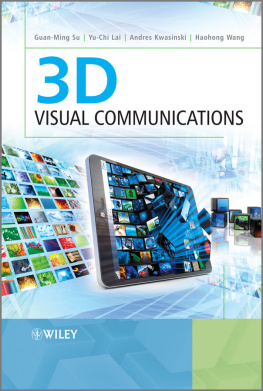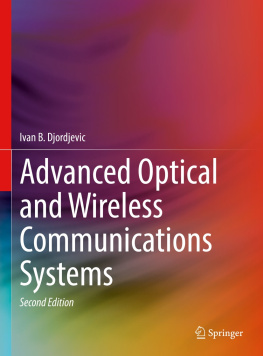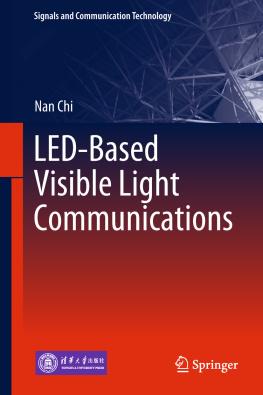
This edition first published 2013
2013 John Wiley and Sons Ltd
Registered office
John Wiley & Sons Ltd, The Atrium, Southern Gate, Chichester, West Sussex, PO19 8SQ, United Kingdom
For details of our global editorial offices, for customer services and for information about how to apply for permission to reuse the copyright material in this book please see our website at www.wiley.com.
The right of the author to be identified as the author of this work has been asserted in accordance with the Copyright, Designs and Patents Act 1988.
All rights reserved. No part of this publication may be reproduced, stored in a retrieval system, or transmitted, in any form or by any means, electronic, mechanical, photocopying, recording or otherwise, except as permitted by the UK Copyright, Designs and Patents Act 1988, without the prior permission of the publisher.
Wiley also publishes its books in a variety of electronic formats. Some content that appears in print may not be available in electronic books.
Designations used by companies to distinguish their products are often claimed as trademarks. All brand names and product names used in this book are trade names, service marks, trademarks or registered trademarks of their respective owners. The publisher is not associated with any product or vendor mentioned in this book. This publication is designed to provide accurate and authoritative information in regard to the subject matter covered. It is sold on the understanding that the publisher is not engaged in rendering professional services. If professional advice or other expert assistance is required, the services of a competent professional should be sought.
Library of Congress Cataloging-in-Publication Data
Su, Guan-Ming.
3D visual communications / Guan-Ming Su, Yu-Chi Lai, Andres Kwasinski, Haohong Wang.
pages cm
Includes bibliographical references and index.
ISBN 978-1-119-96070-6 (cloth)
1. Multimedia communications. 2. Three-dimensional display systems. I.Lai, Yu-Chi. II.Kwasinski, Andres.
III.Wang, Haohong, 1973- IV.Title. V.Title: Three dimensional visual communications.
TK5105.15.S83 2013
006.7 dc23
2012031377
A catalogue record for this book is available from the British Library.
ISBN: 978-1-119-96070-6
Preface
As the Avatar 3D movie experience swept the world in 2010, 3D visual content has become the most eye-catching spot in the consumer electronics products. This 3D visual wave has spread to 3DTV, Blu-ray, PC, mobile, and gaming industries, as the 3D visual system provides sufficient depth cues for end users to acquire better understanding of the geometric structure of the captured scenes, and nonverbal signals and cues in visual conversation. In addition, 3D visual systems enable observers to recognize the physical layout and location for each object with immersive viewing experiences and natural user interaction, which also makes it an important topic for both academic and industrial researchers.
Living in an era of widespread mobility and networking, where almost all consumer electronic devices are endpoints of the wireless/wired networks, the deployment of 3D visual representation will significantly challenge the network bandwidth as well as the computational capability of terminal points. In other words, the data volume received in an endpoint required to generate 3D views will be many times that of a single view in a 2D system, and hence the new view generation process sets a higher requirement for the endpoint's computational capability. Emerging 4G communication systems fit very well into the timing of 3D visual communications by significantly improving the bandwidth as well as introducing many new features designed specifically for high-volume data communications.
In this book, we aim to provide comprehensive coverage of major theories and practices involved in the lifecycle of a 3D visual content delivery system. The book presents technologies used in an end-to-end 3D visual communication system, including the fundamentals of 3D visual representation, the latest 3D video coding techniques, communication infrastructure and networks in 3D communications, and 3D quality of experience.
This book targets professionals involved in the research, design, and development of 3D visual coding and 3D visual transmission systems and technologies. It provides essential reading for students, engineers, and academic and industrial researchers. This book is a comprehensive reference for learning all aspects of 3D graphics and video coding, content creation and display, and communications and networking.
Organization of the book
This book is organized as three parts:
- principles of 3D visual systems: 3D graphics and rending, 3D display, and 3D content creation are all well covered
- visual communication: fundamental technologies used in 3D video coding and communication system, and the quality of experience. There are discussions on various 3D video coding formats and different communication systems, to evaluate the advantages of each system
- advances and applications of 3D visual communication
Chapter 1 overviews the whole end-to-end 3D video ecosystem, in which we cover key components in the pipeline: the 3D source coding, pre-processing, communication system, post-processing, and system-level design. We highlight the challenges and opportunities for 3D visual communication systems to give readers a big picture of the 3D visual content deployment technology, and point out which specific chapters relate to the listed advanced application scenarios.
3D scene representations are the bridging technology for the entire 3D visual pipeline from creation to visualization. Different 3D scene representations exhibit different characteristics and the selections should be chosen according to the requirement of the targeted applications. Various techniques can be categorized according to the amount of geometric information used in the 3D representation spectrum; at one extreme is the simplest form via rendering without referring to any geometry, and the other end uses geometrical description. Both extremes of the technology have their own advantages and disadvantages. Therefore, hybrid methods, rendering with implicit geometries, are proposed to combine the advantages and disadvantages of both ends of the technology spectrum to better support the needs of stereoscopic applications. In Chapter 2, a detailed discussion about three main categories for 3D scene representations is given.
In Chapter 3, we introduce the display technologies that allow the end users to perceive 3D objects. 3D displays are the direct interfaces between the virtual world and human eyes and these play an important role in reconstructing 3D scenes. We first describe the fundamentals of the human visual system (HVS) and discuss depth cues. Having this background, we introduce the simplest scenario to support stereoscopic technologies (two-view only) with aided glasses. Then, the common stereoscopic technologies without aided glasses are presented. Display technologies to support multiple views simultaneously are addressed to cover the head-tracking-enabled multi-view display, occlusion-based and reflection-based multi-view system. At the end of this chapter, we will briefly discuss the holographic system.
In Chapter 4, we look at 3D content creation methods, from 3D modeling and representation, capturing, 2D to 3D conversion and, to 3D multi-view generation. We showcase three practical examples that are adopted in industrial 3D creation process to provide a clear picture of how things work together in a real 3D creation system.
Next page











